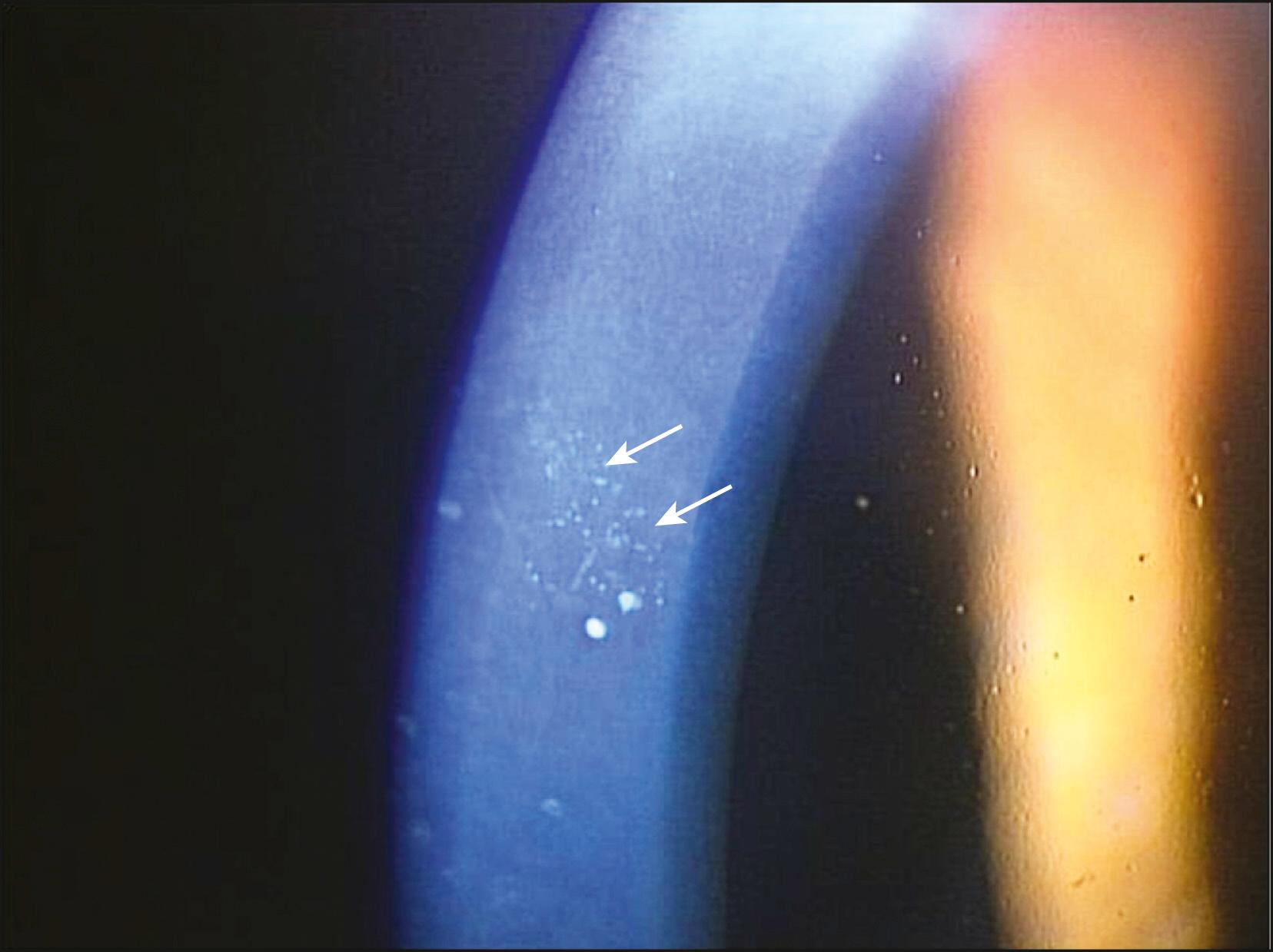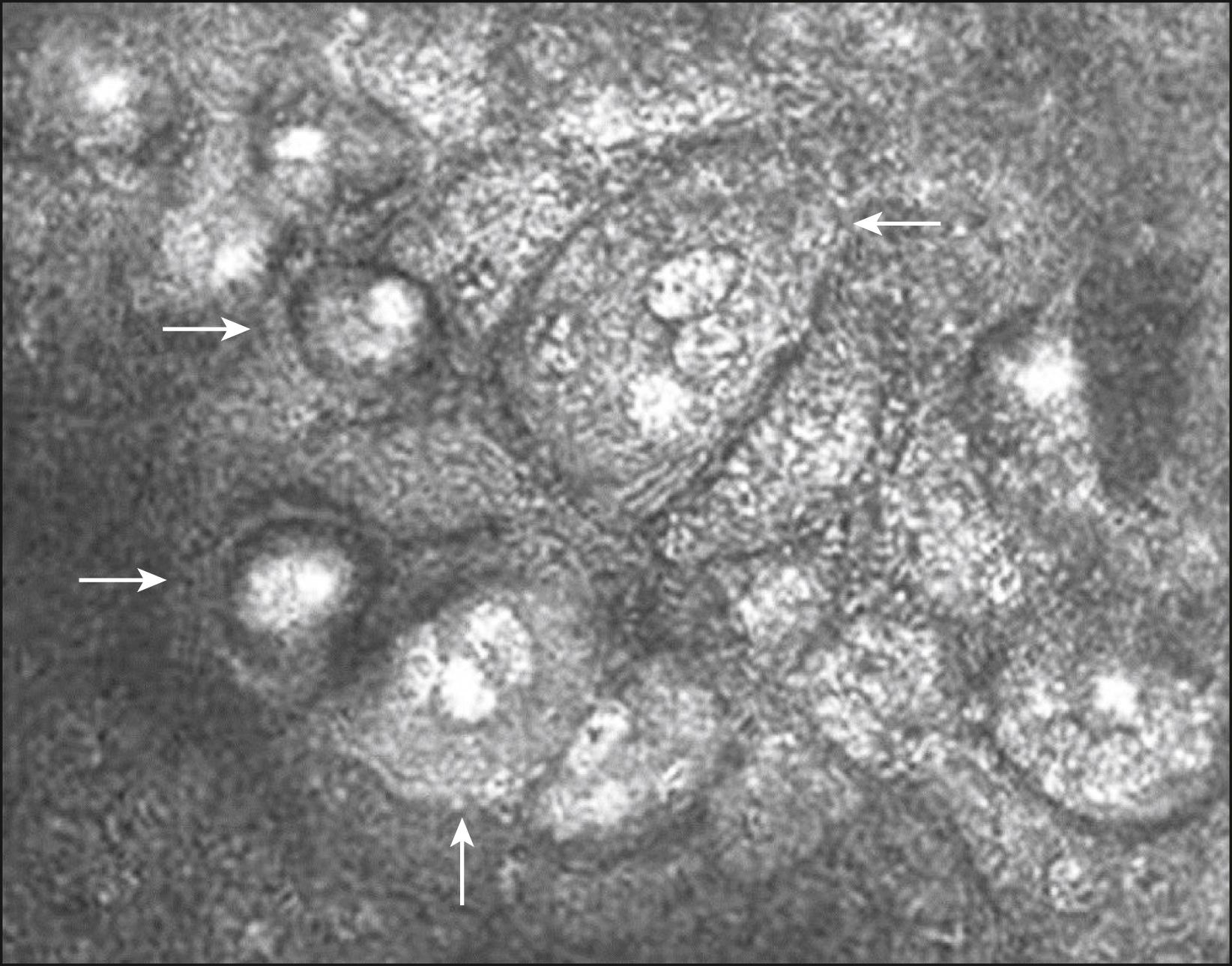Physical Address
304 North Cardinal St.
Dorchester Center, MA 02124
Cytomegalovirus (CMV) corneal endotheliitis presents with corneal edema, keratic precipitates, and mild anterior chamber inflammation.
Epstein-Barr virus can cause a monocular follicular conjunctivitis, conjunctival nodules, and a multifocal stromal keratitis.
Acute hemorrhagic conjunctivitis can be caused by enterovirus 70 and coxsackie A24.
Zika virus is an emerging entity that has affected millions worldwide and can cause nonpurulent conjunctivitis, congenital glaucoma, anterior and posterior uveitis, and chorioretinal scarring.
Rubeola (measles) is having a resurgence in the United States and other Western countries, associated with declining vaccination rates. Ocular surface involvement in measles is typically self-limited.
Ebola ocular manifestations includes conjunctival injection, subconjunctival hemorrhage, excessive lacrimation, and uveitis.
This chapter addresses the anterior segment manifestations of the less common viral infections (summarized in Table 80.1 ). Clues from systemic manifestations may help identify the specific causative virus. This chapter describes DNA viruses from the Poxviridae and Herpesviridae (excluding herpes simplex and herpes zoster) families. The RNA viruses affecting the eye are members of the Picornaviridae , Togaviridae , Paramyxoviridae , Flaviviridae , Bunyavirale, Orthomyxoviridae , and Filoviridae families. ,
| Virus | Anterior Segment Findings | Nonocular Findings |
|---|---|---|
| DNA Viruses | ||
| Poxviridae | ||
| Variola virus | Cicatrizing pustules, catarrhal conjunctivitis, stromal keratitis | Maculopapular rash, vesicles, and pustules; pitting scars and skin depigmentation; fever |
| Vaccinia virus | Superficial punctate keratopathy, stromal keratitis, and scarring, extensive lid edema | Disseminated vaccinia |
| Herpesviridae | ||
| Cytomegalovirus | Catarrhal conjunctivitis, dendritic keratitis, stromal keratitis, endotheliitis, iridocyclitis | Mononucleosis-like infection, chorioretinitis, congenital anomalies |
| Epstein-Barr virus | Follicular conjunctivitis, stromal keratitis, nummular keratitis | Infectious mononucleosis |
| Papovaviridae | ||
| Human papillomavirus | Lid margin and conjunctival papillomas, squamous cell cancer | Papillomas and cancer of the cervical, anogenital region, respiratory tract, and skin |
| RNA Viruses | ||
| Picornaviridae | ||
| Enterovirus and coxsackievirus | Acute hemorrhagic conjunctivitis, rare epithelial keratopathy | Lymphadenopathy, fever, malaise, upper respiratory infection |
| Togaviridae | ||
| Rubella (German measles) virus | ||
| Acquired Congenital |
Mild epithelial keratitis, follicular conjunctivitis Microphthalmos, congenital cataracts |
Thrombocytopenia, encephalitis Cardiac malformations, deafness, dental anomalies, intellectual impairment |
| Chikungunya | Conjunctivitis, episcleritis, anterior uveitis, pigmented keratic precipitates | Fever, myalgias, debilitating arthralgias |
| Flaviviridae | ||
| Zika | Conjunctivitis, anterior uveitis, congenital glaucoma, iris coloboma, lens subluxation | Rash, fever, arthralgias Microcephaly and central nervous system developmental abnormalities in congenital cases |
| West Nile | Hemorrhagic conjunctivitis, anterior uveitis | Often asymptomatic, high fever, chills, malaise, myalgias |
| Dengue, yellow fever | Ocular irritation, subconjunctival hemorrhage, orbital hemorrhage, anterior uveitis | Sudden onset fever, severe headache, chills, arthralgias |
| Bunyavirales | ||
| Sandfly fever (pappataci fever), Rift valley fever | Ocular irritation, conjunctivitis, anterior uveitis | Fatigue, abdominal pain, fever, arthralgias, tachycardia, headache, meningoencephalitis |
| Paramyxoviridae | ||
| Rubeola (measles) virus | Acute follicular conjunctivitis, superficial punctate keratopathy, conjunctival Koplik spots | Morbilliform rash, fever, cough, coryza |
| Mumps virus | Follicular keratitis, rare stromal keratitis, endotheliitis | Parotitis, orchitis, meningitis |
| Newcastle disease virus | Follicular conjunctivitis, rare punctate keratitis or subepithelial infiltrates | Encephalitis, gastroenteritis |
| Orthomyxoviridae | ||
| Influenza virus | Mild catarrhal conjunctivitis | Fever, chills, myalgias, malaise |
| Filoviridae | ||
| Ebola | Conjunctival injection, subconjunctival hemorrhage, excessive lacrimation, uveitis | Fever, weakness, vomiting, diarrhea, arthralgias, and myalgias |
Poxviridae are large, encapsulated, double-stranded DNA viruses that most commonly affect the skin. Variola and its counterpart, vaccinia, and molluscum contagiosum have been reported to affect the eye and ocular adnexa. A handful of reports describe ocular involvement by cowpox or orf. ,
Variola, the causative agent for smallpox, was declared eradicated by the World Health Organization in May 1980 after worldwide mass vaccination programs. Resurgence of this infection has been a concern since this virus has been implicated as a possible pathogen in bioterrorism. Smallpox is transmitted by the inhalation of airborne secretions and is highly contagious. An initial maculopapular rash develops into vesicles and then into pustules. Healing of the pustules leaves depigmented scars and pits.
Involvement of the lids with vesicles causes severe edema with closure of the lids. Cicatrization of pustules occurring at the ciliary border may result in entropion, madarosis, trichiasis, and punctual stenosis. In severe cases, there is a catarrhal or purulent conjunctivitis. Inflammation extending onto the limbus and cornea can become secondarily infected, producing ulceration, interstitial or disciform keratitis, and perforation of the globe.
No specific treatment is available. Routine vaccination of the general public, the primary means of prophylaxis, has been discontinued after global eradication of the virus.
Vaccinia has been encountered infrequently since the discontinuation of vaccinia inoculation as a prophylaxis for smallpox. Vaccinia infection is usually mild, conferring immunity against variola (smallpox), cowpox, and monkeypox. Cell-mediated immunity is critical in containing and eliminating vaccinia infection. Pregnant women, immunocompromised individuals, and atopic persons with eczema or chronic dermatitis may develop disseminated vaccinia.
Ocular involvement is thought to be by autoinoculation from the vaccination site by hand-to-eye contact. Vaccinial vesicles on the eyelid coalesce on an erythematous base accompanied by severe edema that may mimic orbital cellulitis. Vesicular lesions of the eyelid margin may scar, leading to loss of eyelashes, distortion of the eyelid, and epiphora. Vesicles may spread to the conjunctiva and involve the cornea as a marginal infiltrate or stromal keratitis. The inflammatory keratitis may result in permanent corneal scarring.
Treatments for ocular vaccinia include intramuscular hyperimmune vaccinia immunoglobulin, topical vidarabine, trifluorothymidine, and idoxuridine. ,
The herpes viruses are enveloped, icosahedral, double-stranded DNA viruses that cause a wide variety of ocular infections. Herpes simplex and herpes zoster infections are discussed elsewhere (see Chapter 78, Chapter 79 ). Cytomegalovirus (CMV) and Epstein-Barr virus less frequently involve the anterior segment.
CMV is a ubiquitous herpesvirus, with seropositivity in humans exceeding 50% of the population. CMV infection can range from subclinical and asymptomatic infection to an infectious mononucleosis-like illness in young adults to severe pneumonia, hepatitis, and colitis in immunocompromised individuals. Transplacental CMV infection can be severe, with jaundice, hepatosplenomegaly, thrombocytopenia, microcephaly, seizures, and cerebral calcification. , Primary ocular disease can manifest as chorioretinitis and is seen in more than 20% of infected infants. Optic nerve hypoplasia and coloboma, optic nerve atrophy, cataracts, Peters anomaly, microphthalmia, and anophthalmia have been reported in association with congenital CMV infection.
In patients with AIDS, CMV causes a devastating necrotizing retinochoroiditis indicative of a severely weakened immune system. , With the development of highly active antiretroviral therapy (HAART), the incidence of CMV retinitis is much lower and the presentation of this infection has changed. ,
First reported in 2006, CMV endotheliitis is perhaps the most characteristic anterior segment finding and can present with corneal edema in the setting of keratic precipitates, endothelial destruction, and a mild anterior chamber reaction. , Common manifestations of CMV endotheliitis include corneal edema (73.4%), coin-shaped keratic precipitates (70.6%) ( Fig. 80.1 ), anterior chamber inflammation (67.9%), and linear keratic precipitates (8.3%). Treatments for CMV endotheliitis include topical ganciclovir, systemic ganciclovir, systemic valganciclovir, or a combination of topical and systemic therapy. After treatment, 36% of cases showed recurrence, and these patients were placed back on anti-CMV treatment.

Diagnosis can be made by observing these typical findings on slit lamp examination and with polymerase chain reaction (PCR) analysis of the aqueous fluid. Confocal microscopy can serve as an adjunctive modality for diagnosing CMV endotheliitis, by which the pathognomonic owl’s-eye morphology may be identified at the level of the corneal endothelium ( Fig. 80.2 ). These confocal findings may be reversible upon resolution of the endotheliitis and could potentially serve as a noninvasive monitoring tool.

A recent study suggests that CMV may be highly prevalent in cases of endothelial graft failure in patients after penetrating keratoplasty in a Southeast Asian population. The CMV-positive cases were notable for a more extensive pattern of keratic precipitates with heavy pigmentation and a lack of vascularization of the donor grafts. These cases were subsequently treated with oral or topical ganciclovir, although all grafts eventually failed despite this treatment.
The Epstein-Barr virus (EBV) is a widespread virus transmitted through oral secretions. EBV has been implicated in infectious mononucleosis, nasopharyngeal carcinoma, Sjögren syndrome, oral hairy leukoplakia, and Burkitt lymphoma. ,
The most common ocular manifestation of EBV is a transient, monocular follicular conjunctivitis. Two distinct types of stromal keratitis have been described: (1) discrete, sharply demarcated, multifocal, pleomorphic, ring-shaped granular anterior stromal opacities and (2) soft, blotchy, pleomorphic, multifocal infiltrates predominantly involving the peripheral cornea. Subepithelial infiltrates resembling those found in adenoviral keratitis, stellate microdendrites, and nummular keratitis also may be observed. Other manifestations that occur less frequently include conjunctival nodules ( Fig. 80.3 ), periorbital edema, episcleritis, and uveitis. , EBV has been postulated as the pathogenetic factor in the irido-corneal-endothelial syndrome and Parinaud oculoglandular syndrome.

Become a Clinical Tree membership for Full access and enjoy Unlimited articles
If you are a member. Log in here